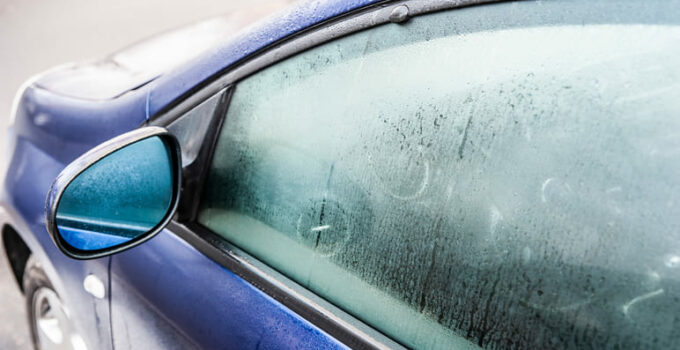
There are many reasons for moisture in the car. But regardless of whether the cause was an open window in the rain or the perspiration of the occupants; Moisture can damage your vehicle substantially and must therefore always be removed as soon as possible. The vehicle electronics in particular, but also the bodywork, could otherwise take it amiss. This causes corrosion or the rusting of certain components is accelerated considerably. But to cut a long story short – in this article we explain how moisture can get into the vehicle and how you can get rid of it quickly.
Contents
How does water and moisture get into your car?

In many cases, this happens through carelessness. It happens again and again that vehicle windows are left open or open while it is raining heavily. This allows the water to enter the vehicle interior directly through the window openings. In this case, you should try to absorb as much of the liquid as possible so that water does not first stand in the footwell of the car. You should also dry the upholstery as quickly as possible to avoid water and mold stains. If you do not dispose of this often large amount of liquid properly, mold can also develop due to the moisture in the car.
Another complex of causes are, of course, a wide variety of defects, all of which can lead to leaks in the vehicle's outer shell. These include, for example, broken seals or sunroofs that can no longer be closed properly. In addition, the vehicle windows can also leak because, for example, your windscreen was not glued in properly. To avoid such problems as much as possible, make sure that the vehicle seals are lubricated regularly and also replaced if necessary. In addition to special lubricants, milking fat is also ideal for making the seals nice and supple again. This is particularly important at the beginning of autumn when it starts to rain again.
It is also important to keep the channels through which the rainwater can be drained free. Over time, these become clogged with dirt and wear and tear, so that they have to be made usable again. If you fail to do this, the rainwater will stand in unfavorable places or find another way. Incidentally, standing water or moisture promote rust spots, so that ultimately more leaks can occur.
In addition, there is also the possibility that you bring the moisture into the vehicle interior yourself. This happens, for example, when you sweat profusely. If there is also a defect in the heat exchangers used or your air conditioning system, more and more moisture will quickly collect. A clogged cabin air filter can also cause this type of problem.
How do you recognize excess moisture inside the vehicle

In winter this is very simple: If there is too much moisture in the interior, your windscreen freezes over from the inside. If your seats feel wet or if your vehicle smells musty, the existing moisture opens the door to mold spores. So that it doesn't get that bad in the first place, you should take some simple, easy-to-implement measures as early as possible (possibly even preventively). In order to find where the water has penetrated, you should spray your car with a hose from all sides and directions. A second person sitting in your car should try to see where the water can get inside. Once you have found the cause, it can be eliminated more easily.
How to get rid of interior vehicle moisture?

First of all, the easiest way to combat moisture in the car is with your heating and air conditioning system, if the latter is available. As long as it is still sufficiently warm and dry outside (+6°C) it is often sufficient to operate the vehicle ventilation at the maximum level for a longer period of time. The moisture can then easily escape through your open windows. This works particularly well when there is as much moisture in the air as possible and it can be transported away efficiently.
Your air conditioner can also help with this problem. This system cools by extracting moisture from the air and thereby cooling it down. If you want to use your air conditioner for dehumidification, you should first switch to „air recirculation mode“ switch on and then set the system to the lowest possible target temperature. In this way, as much moisture as possible condenses in the air conditioning area.
Another very good tool are so-called passive dehumidifiers. These can bind moisture and be regenerated with the help of a microwave, for example. Such dehumidifiers are very efficient and can also be made from cat litter and a sock. A small heater can also be used to dry your car.
Conclusion
It doesn't have to be an expensive trip to the garage to get a little moisture out of your vehicle. This applies in particular if it is only condensate, which is caused, for example, by sweating. Nevertheless, you should always look for the cause first so that you don't experience any unpleasant surprises later. For example, if your pane is leaking, this problem must first be eliminated. Otherwise, all methods presented here are only symptomatic and not causal methods.
A tip from CarTipsandmore: There are a number of ways to remove moisture from your vehicle. Don't give yourself too much time to act. This is the only way to avoid major consequential damage in the short or long term. The best proven household remedy is and remains cat litter – in the end, commercially available reusable dehumidifiers also work on a similar principle. For example, you can fill this home remedy in old socks and then place it in the vehicle. However, it is important to remember that further moisture penetration must first be prevented and that this tool can only remove a limited amount of moisture. So if it gets really wet, it is advisable to absorb and dispose of larger amounts of liquid first.
